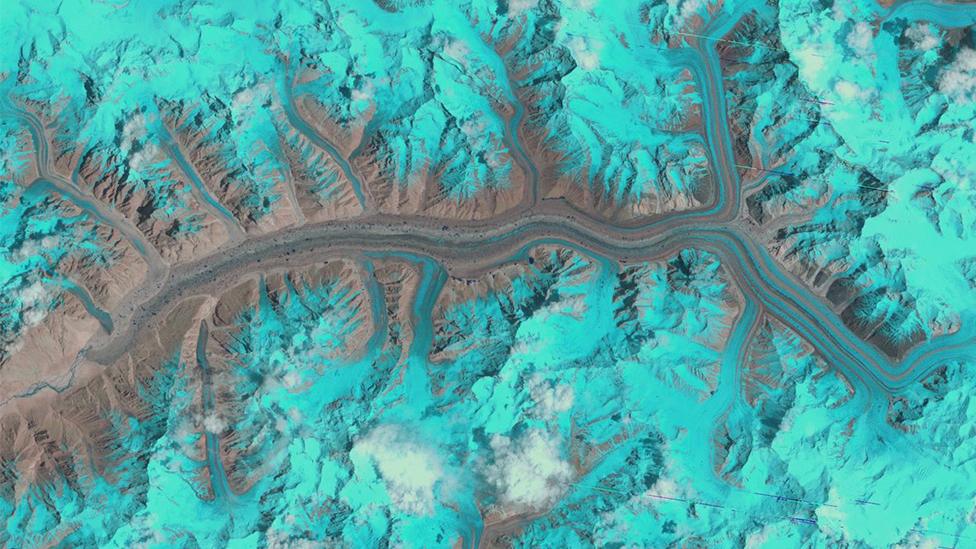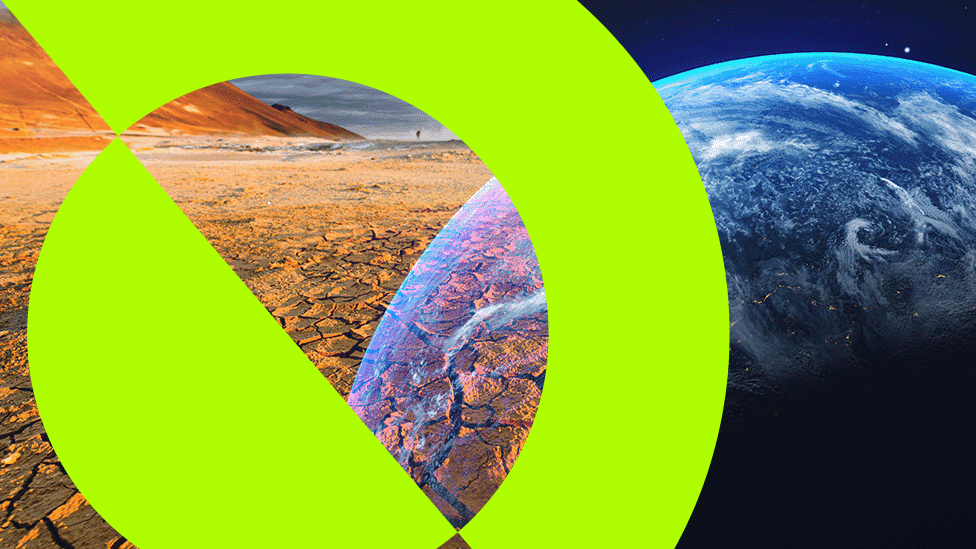Dangerous heatwave starts hitting US and Canada
- Published
Temperatures rising for USA
Extremely hot weather has started to hit most of the United States, with temperatures set to peak over the weekend, meteorologists say.
The heatwave could affect about 200 million people in major cities like New York, Washington and Boston in the East Coast, and the Midwest region too.
In some places, temperatures could be close to or exceed 100F (38C). Parts of Canada are also being hit.
Experts link more frequent heatwaves in recent years to climate change.
The world experienced its hottest June on record this year, with an average temperature worldwide of 61.6F (16.4C), according to new data.
Earlier this month, the US state of Alaska, part of which lies inside the Arctic Circle, registered record high temperatures.
Which areas are hit by the latest heatwave?
The heatwave is hitting an area stretching from the Central Plains of Colorado and Kansas, to the Great Lakes in the north-east.
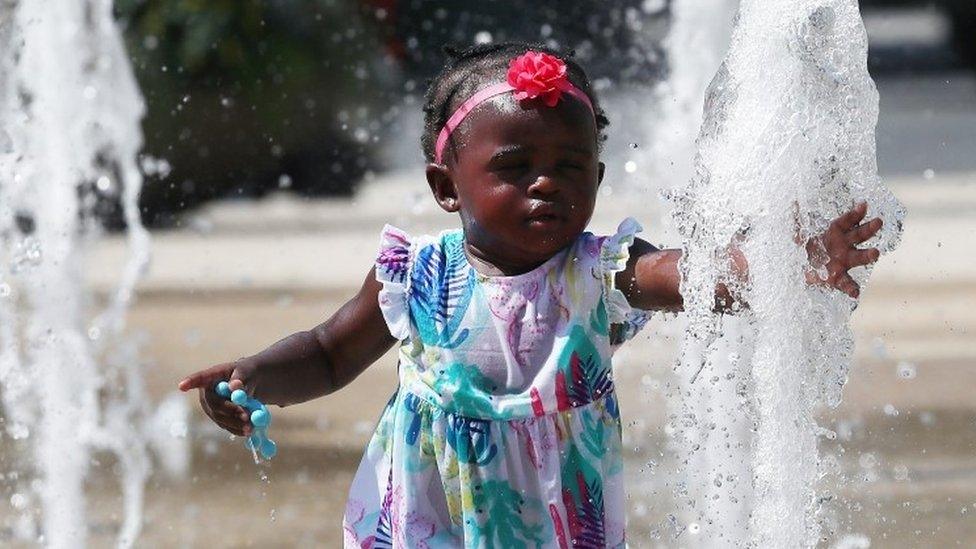
A little girl cools off in water fountains in Washington DC
Temperatures are also rising in most areas of the East Coast. The National Weather Service (NWS) published a map of the areas that are affected.
"The hazy, hot and humid conditions will persist through the weekend. Be smart and stay cool!" it warned.
Allow X content?
This article contains content provided by X. We ask for your permission before anything is loaded, as they may be using cookies and other technologies. You may want to read X’s cookie policy, external and privacy policy, external before accepting. To view this content choose ‘accept and continue’.

New York Mayor Bill de Blasio declared "a local emergency due to the extreme heat" in the city.
"This is a heatwave coming up these next days. It's serious stuff," the mayor said in a video posted on Twitter. "Friday is going to be bad. Saturday is going to be really, really bad on through Sunday."
Allow X content?
This article contains content provided by X. We ask for your permission before anything is loaded, as they may be using cookies and other technologies. You may want to read X’s cookie policy, external and privacy policy, external before accepting. To view this content choose ‘accept and continue’.

He urged New Yorkers to take the threat seriously, to stay hydrated, and to not go out in the hot weather. Mr de Blasio added that 500 "cooling centres" were being opened across New York.
Similar measures were being taken in Detroit and other cities.
In Canada, heat warnings have been issued for parts of the provinces of Quebec, Ontario and Nova Scotia. Daytime temperatures in Toronto could feel like 40C (104F) on Friday and Saturday, when humidity is factored in. Severe thunderstorms are also expected.
Canadian meteorologists say that in Montreal the temperature could feel like 45C with humidity over the next two days.
What is the forecast?
US meteorologists say the heatwave is expected to continue through the weekend, and some cities may see their highest temperatures in years.
In some cities it might feel as hot as in California's Death Valley - a desert region known for its extreme heat. But they say a dramatic change is on the way early next week, when it is expected to suddenly cool off.
Interactive content: Upgrade your browser for the full experience. Alternatively, click here for a list of climate change terms and what they mean.
Climate change translator
What do all the terms mean?
Skip to main story-
1.5 degrees
Keeping the rise in global average temperature below 1.5 degrees Celsius will avoid the worst impacts of climate change, scientists say. That’s compared with ‘pre-industrial’ times. The world has already warmed about 1C since then.
-
2 degrees
The original target for limiting the rise in global average temperature. Recent research points to 1.5 degrees being a far safer limit.
-
3 degrees
The current likely rise in average global temperature by the year 2100 if countries keep their promises to cut emissions of greenhouse gases, which are driving climate change.
-
4 degrees
A prediction of the likely rise in average temperature by 2100 if no further action is taken. This would see major sea-level rise, with many coastal areas becoming uninhabitable, as well as regular severe heatwaves and massive disruption to agriculture.
-
Adaptation
An action that helps cope with the effects of climate change - for example building houses on stilts to protect from flooding, constructing barriers to hold back rising sea levels or growing crops which can survive high temperatures and drought.
-
AGW
Stands for 'Anthropogenic Global Warming', which means the rise in temperatures caused by human activity like the burning of fossil fuels such as coal and oil. This produces carbon dioxide and other so-called greenhouse gases, which trap heat in the atmosphere and cause the planet to become warmer. This is in addition to changes in the climate which happen because of natural processes.
-
Arctic ice
The Arctic Ocean freezes in winter and much of it then thaws in summer, and the area thawing has increased by 40% over the past few decades. The Arctic region is warming twice as fast as the rest of the planet.
-
Attribution
Attribution is the process by which scientists try to explain whether climate change has made a particular weather event - like a heatwave - more likely.
-
Average temperature
The average temperature of the world is calculated with the help of temperature readings taken from weather stations, satellites and ships and buoys at sea. Currently it stands at 14.9C.
-
BECCS
Stands for 'Bio Energy with Carbon Capture and Storage'. It's the name for a system in which crops are grown (which draws in carbon dioxide from the air) and when they are burned to make electricity, carbon emissions are captured and then stored. Scientists see this is a key way to keep the lights on while not adding to global warming, but the technology is in its infancy.
-
Biofuel
A fuel derived from renewable, biological sources, including crops such as maize, palm oil and sugar cane, and some forms of agricultural waste.
-
Biomass
Biomass is plant or animal material used to produce energy or as raw materials for other products. The simplest example is cow dung; another is compressed wood pellets, which are now used in some power stations.
-
Carbon
Carbon is a chemical element which is sometimes described as a building block for all life on Earth because it is found in most plant and animal life. It is also found in fuels like petrol, coal and natural gas, and when burned, is emitted as a gas called carbon dioxide.
-
Carbon capture
The trapping and removal of carbon dioxide gas from the air. The gas can then be reused, or injected into deep underground reservoirs. Carbon capture is sometimes referred to as geological sequestration. The technology is currently in its infancy.
-
Carbon dioxide
Carbon dioxide is a gas in the Earth's atmosphere. It occurs naturally and is also a by-product of human activities such as burning fossil fuels. It is the principal greenhouse gas produced by human activity.
-
Carbon footprint
The amount of carbon emitted by an individual or organisation in a given period of time, or the amount of carbon emitted during the manufacture of a product.
-
Carbon neutral
A process where there is no net release of carbon dioxide (CO2). For example, growing biomass takes CO2 out of the atmosphere, while burning it releases the gas again. The process would be carbon neutral if the amount taken out and the amount released were identical. A company or country can also achieve carbon neutrality by means of carbon offsetting. The phrase 'net zero' has the same meaning.
-
Carbon offsetting
Carbon offsetting is most commonly used in relation to air travel. It allows passengers to pay extra to help compensate for the carbon emissions produced from their flight. The money is then invested in environmental projects - like planting trees or installing solar panels - which reduce the carbon dioxide in the air by the same amount. Some activists have criticised carbon offsetting as an excuse to continue polluting, arguing that it does little to change behaviour.
-
Carbon sink
Anything which absorbs more carbon dioxide than it emits. In nature, the main carbon sinks are rainforests, oceans and soil.
-
CCU
Stands for ‘Carbon Capture and Utilisation’. This consists of using technology to draw carbon dioxide from the atmosphere and turn it into products like biofuels and plastics.
-
Climate change
A pattern of change affecting global or regional climate, as measured by average temperature and rainfall, and how often extreme weather events like heatwaves or heavy rains happen. This variation may be caused by both natural processes and by humans. Global warming is an informal term used to describe climate change caused by humans.
-
Climate model
Climate models are computer simulations of how the atmosphere, oceans, land, plants and ice behave under various levels of greenhouse gases. This helps scientists come up with projections for what Earth will be like as global warming continues. The models do not produce exact predictions, but instead suggest ranges of possible outcomes.
-
Climate negotiations
Climate negotiations take place every year as the United Nations brings governments together to discuss action to stop climate change. The goal is usually a collective agreement to reduce carbon emissions by certain dates. The latest of these is the Paris Agreement of 2015 which set the targets of limiting warming to 2C or 1.5C if possible. Negotiations are always difficult because many countries are heavily dependent on fossil fuels and worry about the effects of any change on their economies.
-
CO2
Means carbon dioxide, a naturally occurring gas which is also a major product of human activity such as burning fossil fuels. Increasing levels of carbon dioxide in the atmosphere means more heat is retained, causing the planet to warm up.
-
COP
Stands for 'Conference of the Parties'. It is the name for the annual UN negotiations on climate change under what is called the United Nations Framework Convention on Climate Change (see UNFCCC). The aim is to prevent dangerous human interference with the climate.
-
Copenhagen
A UN climate summit was held in Copenhagen in 2009 which descended into acrimony and ended with countries only agreeing a non-binding accord that climate change was "one of the greatest challenges of the present day". The event is widely regarded as one of the least productive since climate negotiations began.
-
Coral bleaching
Coral bleaching refers the change in colour of coral reefs when the ocean temperature rises above a certain level, forcing the corals to eject the algae they normally co-exist with - this turns them white. Coral can recover if the water cools, but lasting damage can be done if it remains too hot.
-
Deforestation
The clearing of forests to make way for farming such as soy crops to feed livestock or palm oil for consumer products. This releases significant levels of carbon dioxide as trees are burned.
-
Deniers
Climate deniers believe that climate change is only taking place because of natural processes and that human activity has no role. They dispute the work of many thousands of experts around the world, whose research has been peer-reviewed and published and is based on research stretching back more than a century.
-
Emissions
Emissions are any release of gases such as carbon dioxide which cause global warming, a major cause of climate change. They can be small scale in the form of exhaust from a car or methane from a cow, or larger-scale such as those from coal-burning power stations and heavy industries.
-
Extreme weather
Extreme weather is any type of unusual, severe or unseasonal weather. Examples could be major heat waves, with temperature records broken, extended droughts as well as cold spells and heavier than usual rainfall. Scientists predict that extreme weather will become more common as the world becomes warmer.
-
Feedback loop
In a feedback loop, rising temperatures change the environment in ways that affect the rate of warming. Feedback loops can add to the rate of warming or reduce it. As the Arctic sea-ice melts, the surface changes from being a bright reflective white to a darker blue or green, which allows more of the Sun’s rays to be absorbed. So less ice means more warming and more melting.
-
Fossil fuels
Fuels such as coal, oil and natural gas were formed when tiny plants and animals flourished in the ancient past, absorbing carbon from the atmosphere, before dying and being crushed over millions of years. When burned, they release carbon dioxide.
-
Geo-engineering
Geo-engineering is any technology which could be used to halt or even reverse climate change. Examples range from extracting carbon dioxide from the atmosphere and storing it underground, to more far-fetched ideas such as deploying vast mirrors in space to deflect the Sun's rays. Some scientists say geo-engineering may prove essential because not enough is being done to reduce emissions of greenhouse gases. Others warn that the technologies are unproven and could have unforeseen consequences.
-
Global temperature
Usually a reference to temperature averaged across the entire planet.
-
Global warming
The steady rise in global average temperature in recent decades, which experts say is mostly caused by human-produced greenhouse gas emissions. The long-term trend continues upwards with 2015, 2016, 2017 and 2018 being the warmest years on record.
-
Green energy
Green energy, sometimes called renewable energy, is generated from natural, replenishable sources. Examples are wind and solar power as well as biomass, made from compressed wood pellets.
-
Greenhouse gases
Natural and human-produced gases that trap heat in the atmosphere and warm the surface. The Kyoto Protocol restricts emissions of six greenhouse gases: carbon dioxide, nitrous oxide, methane, perfluorocarbons, hydrofluorocarbons, and sulphur hexafluoride.
-
Gulf Stream
The Gulf Stream is a warm ocean current which originates in the Gulf of Mexico and flows up the east coast of the United States and across the Atlantic Ocean. Scientists believe Europe would be significantly cooler without it. There is a fear that the stream could be disrupted if rising temperatures melt more polar ice, bringing an influx of freshwater.
-
Hydrocarbon
A hydrocarbon is a substance consisting entirely of hydrogen and carbon. The major fossil fuels - coal, oil and gas - are hydrocarbons and as such, are the main source of emissions linked to climate change.
-
IPCC
The Intergovernmental Panel on Climate Change is a scientific body established by the United Nations and the World Meteorological Organization. Its role is to examine and assess the latest scientific research into climate change. Its report in 2018 warned that the rise in global temperatures should be limited to 1.5C to avoid dangerous impacts.
-
Jetstream
A jetstream is a narrow band of fast-flowing air at high altitude which acts as major influence on the weather. Jetstreams could be disrupted by warming in polar regions, and this may make extreme weather like Europe’s hot summer of 2018 more common.
-
Kyoto Protocol
A set of rules agreed at Kyoto in Japan in 1997, in which 84 developed countries agreed to reduce their combined emissions by 5.2% of their level in 1990.
-
Lukewarmers
A term used to describe people who believe that climate change is real, and being driven by human activity, but that its effects will not be as bad as predicted by scientists.
-
Methane
Methane is a gas which traps about 30 times more heat than carbon dioxide. It is produced by human activity from agriculture – cows emit large amounts – as well as waste dumps and leaks from coal mining. Methane is also emitted naturally from wetlands, termites and wildfires. One big concern is that carbon held in frozen ground in arctic regions will be released as methane as temperatures rise and the ground thaws. This could cause extra, unpredictable global warming.
-
Mitigation
Action that will reduce human-driven climate change. This includes reducing greenhouse gas emissions by switching to renewable power, or capturing greenhouse gases from the atmosphere by planting forests.
-
Net zero
A term used to describe any process where there is no net release of carbon dioxide (CO2). For example, growing biomass takes CO2 out of the atmosphere, while burning it releases the gas again. The process would be net zero if the amount taken out and the amount released were identical. A company or country can also achieve net zero by means of carbon offsetting. Net zero processes or manufactured items are sometimes also describbed as being 'carbon neutral'.
-
Ocean acidification
The ocean absorbs approximately a quarter of human produced carbon dioxide (CO2) from the atmosphere, which helps to reduce the effect of climate change. However, when the CO2 dissolves in seawater, carbonic acid is formed. Carbon emissions from industry in the last 200 years have already begun to alter the chemistry of the world’s oceans. If this trend continues, marine creatures will find it harder to build their shells and skeletal structures, and coral reefs will be killed off. This would have serious consequences for people who rely on them as fishing grounds.
-
Ozone layer
The ozone layer is part of Earth's high atmosphere which contains a large concentration of gas molecules comprising three oxygen atoms called ozone. Ozone helps filter out harmful ultraviolet light from the Sun, which can increase the risk of skin cancer. In the 1980s and 1990s, industrial gases called chlorofluorocarbons (or CFCs) were banned because they damaged the ozone layer. These gases are also potent greenhouse gases, contributing to global warming.
-
PPM / ppm
An abbreviation for 'parts per million', used to describe the concentration of a gas such as carbon dioxide in the atmosphere. The Intergovernmental Panel on Climate Change (IPCC) suggested in 2007 that the world should aim to stabilise greenhouse gas levels at 450 ppm CO2 equivalent in order to avert dangerous climate change. Some scientists, and many of the countries most vulnerable to climate change, argue that the safe upper limit is 350ppm. Modern levels of CO2 broke through 400ppm (at the Mauna Loa Laboratory in Hawaii) in 2013, and continue to climb at about 2-3ppm per year.
-
Pre-industrial
Scientists use a baseline with which to compare the modern rise in temperatures on Earth. The baseline often quoted is 1850-1900, and global temperatures have risen by about 1C since then. The reality, of course, is that industry actually got going much earlier, but there is nonetheless a perceptible uptick in the levels of CO2 and other greenhouse gases in the atmosphere by 1850-1900 and the period is deemed therefore to be a useful marker.
-
Renewable energy
Normally refers to energy sources such as biomass (such as wood and biogas), the flow of water, geothermal (heat from within the earth), wind, and solar.
-
Runaway climate change
Describes how the climate change may suddenly change after passing a 'tipping point', making it even harder to stop or reverse. In 2018, the IPCC said that global emissions must be reduced by 45% by 2030, and to net zero by 2050 to have 50% chance of limiting temperature rises to 1.5C this century.
-
Sea ice
Sea-ice is found in polar regions. It grows in extent and thickness in autumn and winter, and melts in spring and summer. The amount of sea-ice in the Arctic is seen as a key indicator of climate trends because the region is warming faster than most other locations on Earth. The smallest ever extent (in the satellite era) of Arctic sea-ice was recorded in September 2012. The 3.41 million square kilometers was 44% below the 1981-2010 average.
-
Sea level rises
Rising sea levels are predicted to be one of the most drastic impacts of climate change. In this context, there are two main causes for sea-level rise: (1) the expansion of seawater as the oceans warm; and (2) the run-off into the ocean of water from melting ice sheet and glaciers. Current sea levels are about 20cm higher on average than they were in 1900. Year on year, sea levels are presently going up by just over 3mm.
-
Sustainability
Sustainability means consuming the planet's resources at a rate at which they can be replenished. It's sometimes known as 'sustainable development'. Types of renewable energy such as solar or wind power are described as sustainable, while using wood from managed forests where trees are replanted according to how many are cut down is another example.
-
Tipping point
Describes how the climate may suddenly change after passing a ‘tipping point’, making it even harder to stop or reverse. Scientists say it is urgent that policy-makers halve global carbon dioxide emissions by 2030 or risk triggering changes that could be irreversible.
-
UNFCCC
Stands for the United Nations Framework Convention on Climate Change. This is an international treaty, signed at the Earth Summit in Rio de Janeiro in 1992, which stated that countries should work to stabilise greenhouse gas concentrations in the atmosphere to avoid dangerous climate change.
Climate Change Translator
What do all these terms mean?
- Attribution
- Published19 July 2019
1:00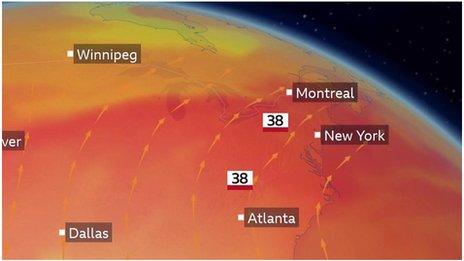
- Published6 July 2019
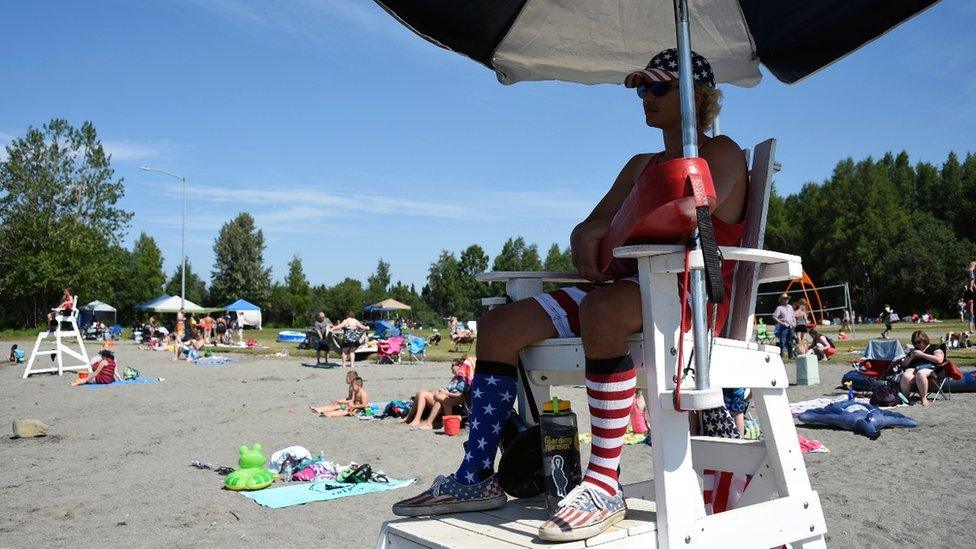
- Published14 January 2020
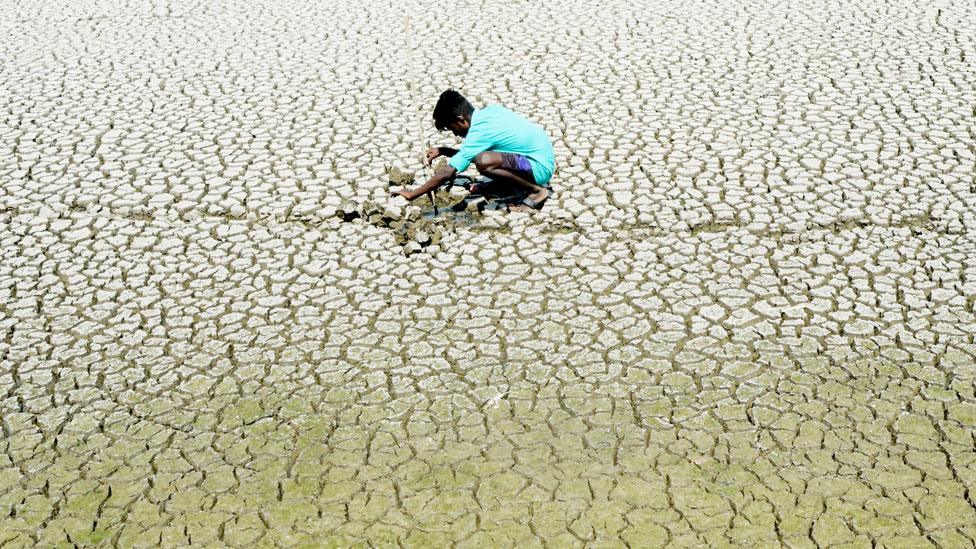
- Published10 December 2018
